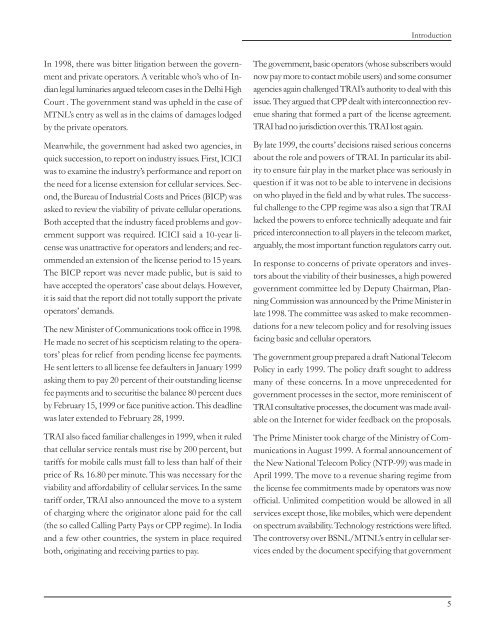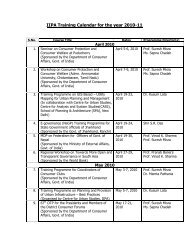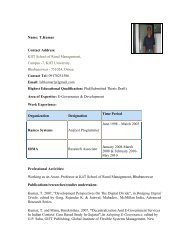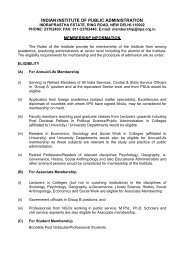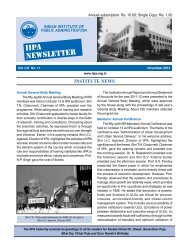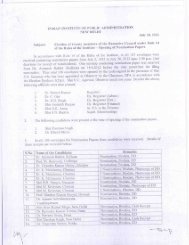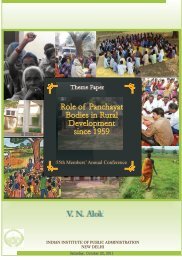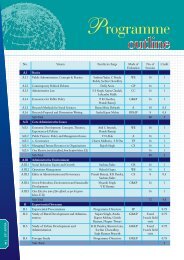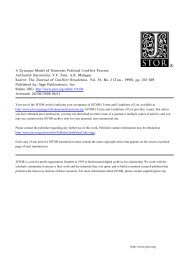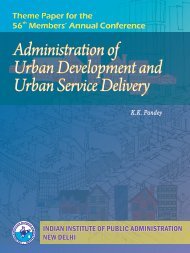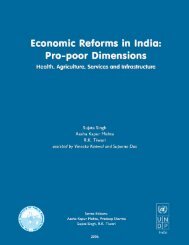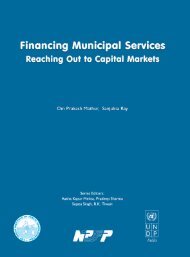India's Telecom Reform - Indian Institute of Public Administration
India's Telecom Reform - Indian Institute of Public Administration
India's Telecom Reform - Indian Institute of Public Administration
Create successful ePaper yourself
Turn your PDF publications into a flip-book with our unique Google optimized e-Paper software.
Introduction<br />
In 1998, there was bitter litigation between the government<br />
and private operators. A veritable who’s who <strong>of</strong> <strong>Indian</strong><br />
legal luminaries argued telecom cases in the Delhi High<br />
Court . The government stand was upheld in the case <strong>of</strong><br />
MTNL’s entry as well as in the claims <strong>of</strong> damages lodged<br />
by the private operators.<br />
Meanwhile, the government had asked two agencies, in<br />
quick succession, to report on industry issues. First, ICICI<br />
was to examine the industry’s performance and report on<br />
the need for a license extension for cellular services. Second,<br />
the Bureau <strong>of</strong> Industrial Costs and Prices (BICP) was<br />
asked to review the viability <strong>of</strong> private cellular operations.<br />
Both accepted that the industry faced problems and government<br />
support was required. ICICI said a 10-year license<br />
was unattractive for operators and lenders; and recommended<br />
an extension <strong>of</strong> the license period to 15 years.<br />
The BICP report was never made public, but is said to<br />
have accepted the operators’ case about delays. However,<br />
it is said that the report did not totally support the private<br />
operators’ demands.<br />
The new Minister <strong>of</strong> Communications took <strong>of</strong>fice in 1998.<br />
He made no secret <strong>of</strong> his scepticism relating to the operators’<br />
pleas for relief from pending license fee payments.<br />
He sent letters to all license fee defaulters in January 1999<br />
asking them to pay 20 percent <strong>of</strong> their outstanding license<br />
fee payments and to securitise the balance 80 percent dues<br />
by February 15, 1999 or face punitive action. This deadline<br />
was later extended to February 28, 1999.<br />
TRAI also faced familiar challenges in 1999, when it ruled<br />
that cellular service rentals must rise by 200 percent, but<br />
tariffs for mobile calls must fall to less than half <strong>of</strong> their<br />
price <strong>of</strong> Rs. 16.80 per minute. This was necessary for the<br />
viability and affordability <strong>of</strong> cellular services. In the same<br />
tariff order, TRAI also announced the move to a system<br />
<strong>of</strong> charging where the originator alone paid for the call<br />
(the so called Calling Party Pays or CPP regime). In India<br />
and a few other countries, the system in place required<br />
both, originating and receiving parties to pay.<br />
The government, basic operators (whose subscribers would<br />
now pay more to contact mobile users) and some consumer<br />
agencies again challenged TRAI’s authority to deal with this<br />
issue. They argued that CPP dealt with interconnection revenue<br />
sharing that formed a part <strong>of</strong> the license agreement.<br />
TRAI had no jurisdiction over this. TRAI lost again.<br />
By late 1999, the courts’ decisions raised serious concerns<br />
about the role and powers <strong>of</strong> TRAI. In particular its ability<br />
to ensure fair play in the market place was seriously in<br />
question if it was not to be able to intervene in decisions<br />
on who played in the field and by what rules. The successful<br />
challenge to the CPP regime was also a sign that TRAI<br />
lacked the powers to enforce technically adequate and fair<br />
priced interconnection to all players in the telecom market,<br />
arguably, the most important function regulators carry out.<br />
In response to concerns <strong>of</strong> private operators and investors<br />
about the viability <strong>of</strong> their businesses, a high powered<br />
government committee led by Deputy Chairman, Planning<br />
Commission was announced by the Prime Minister in<br />
late 1998. The committee was asked to make recommendations<br />
for a new telecom policy and for resolving issues<br />
facing basic and cellular operators.<br />
The government group prepared a draft National <strong>Telecom</strong><br />
Policy in early 1999. The policy draft sought to address<br />
many <strong>of</strong> these concerns. In a move unprecedented for<br />
government processes in the sector, more reminiscent <strong>of</strong><br />
TRAI consultative processes, the document was made available<br />
on the Internet for wider feedback on the proposals.<br />
The Prime Minister took charge <strong>of</strong> the Ministry <strong>of</strong> Communications<br />
in August 1999. A formal announcement <strong>of</strong><br />
the New National <strong>Telecom</strong> Policy (NTP-99) was made in<br />
April 1999. The move to a revenue sharing regime from<br />
the license fee commitments made by operators was now<br />
<strong>of</strong>ficial. Unlimited competition would be allowed in all<br />
services except those, like mobiles, which were dependent<br />
on spectrum availability. Technology restrictions were lifted.<br />
The controversy over BSNL/MTNL’s entry in cellular services<br />
ended by the document specifying that government<br />
5


